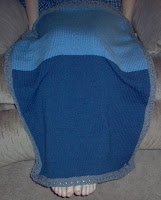 This manual machine knit afghan was a gift to my brother. It is 8' long and 6' wide, done in two tones of olive green. It was made in 3 sections - two sections were striped, and the third was solid. The three sections were then sewn together as shown.
This manual machine knit afghan was a gift to my brother. It is 8' long and 6' wide, done in two tones of olive green. It was made in 3 sections - two sections were striped, and the third was solid. The three sections were then sewn together as shown.Stripes are often the easiest colorways to do. At the end of the appropriate row, just join a new color. If the color changes are repeated, you do not bind off the yarn, but carry it up the side.

Color blocks can be both easier or harder, depending on the size and number of blocks. This Chair Blanket, titled, Feeling Blue? is a simple example. It's a block of dark blue and a block of light blue. The color change was done at the end of the row, just like joining a new skein of yarn, with nothing to carry over.

Patterns start to get tricky. Even a simple border patern, such as the close-up of this cap, are harder because you have to carry both yarns across the back. Pull the yarn too tight, and the item pulls. If the yarn is too loose, then it can catch. Yet a simple border design can make the simplest item much more fetching.
This cap and glove set is a much more difficult example of pattern colorways. It was a gift to my husband, so he got to be the model for this picture. With gloves, you really must be careful about the carried yarn. Too tight, and the wearer will not be able to get their hands in, but too loose, their fingers will catch on the yarn, pulling it our of shape and causing holes.
Using different colors to create pictures is my final example. This baby set used white yarn to create little anchors across the bottom of both the sweater and the cap. This, in my opinion, is the most difficult of all. First you have the yarn carry concerns. Then, since the pattern does not have a static repeat, you must pay very close attention to the charting.
While my examples use just two colors, the information holds true for any number of colors. The more colors you add, the more difficult it becomes.
If you want to try your hand at using colorways to improve your knitting or crochet, I suggest starting with either big color blocks, then stripes. Once you've mastered carrying yarn up the sides of your work, try a simple border pattern.
(My chair blankets are specifically designed for wheelchair use. They are the width of a standard wheelchair, and go just from the lap to just above the floor. No fringe is allowed on the edging. This is to keep the afghan from getting caught on the wheels or dragging on the fllor. For Feeling Blue? and other wheelchair lap robes, please visit our store at http://www.fullhousecrafts.etsy.com/)



No comments:
Post a Comment